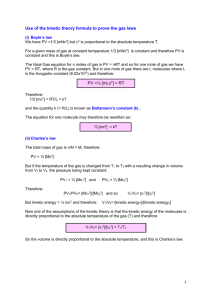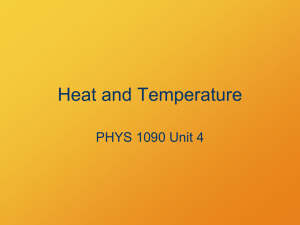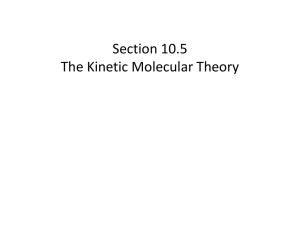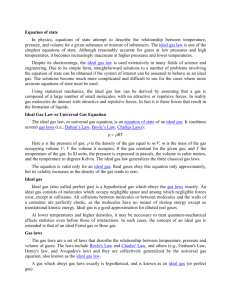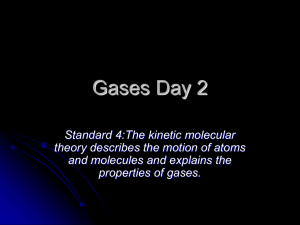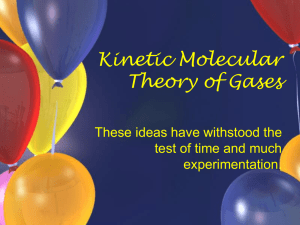02-Kinetic-Theory-of-Gases-Practice-Problem
advertisement
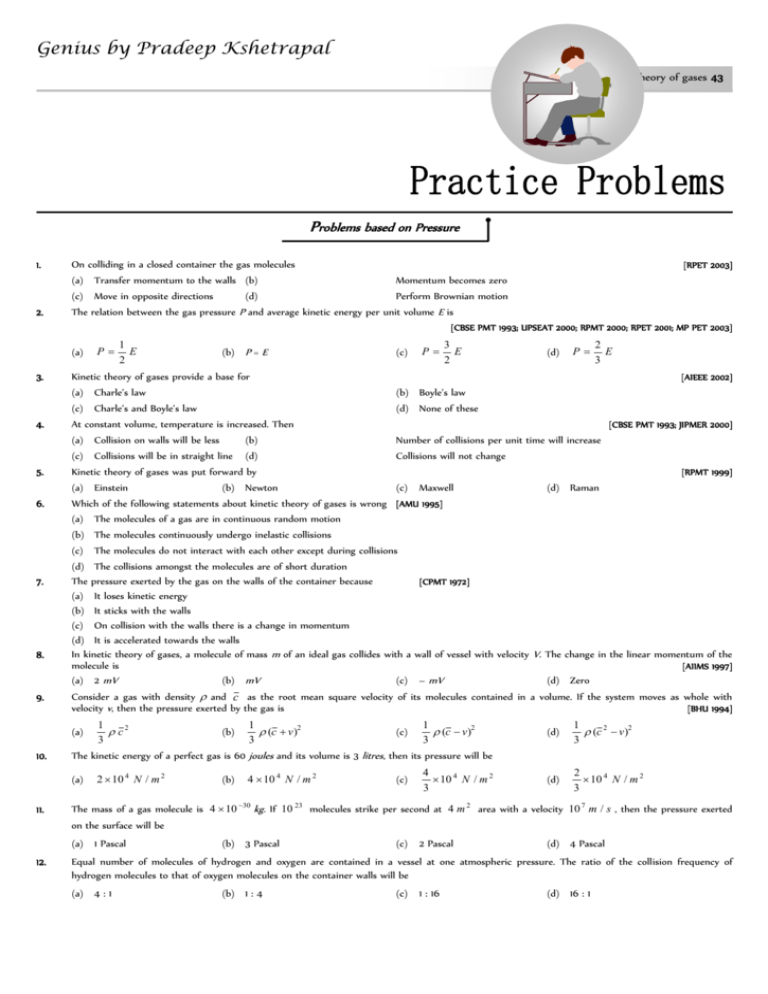
Genius by Pradeep Kshetrapal Kinetic theory of gases 43 Problems based on Pressure 1. 2. On colliding in a closed container the gas molecules (a) Transfer momentum to the walls (b) Momentum becomes zero (c) Move in opposite directions (d) Perform Brownian motion The relation between the gas pressure P and average kinetic energy per unit volume E is [RPET 2003] [CBSE PMT 1993; UPSEAT 2000; RPMT 2000; RPET 2001; MP PET 2003] (a) 3. 4. 5. 6. 7. 8. 9. P 1 E 2 (b) P = E (c) P 3 E 2 2 E 3 Consider a gas with density and c as the root mean square velocity of its molecules contained in a volume. If the system moves as whole with velocity v, then the pressure exerted by the gas is [BHU 1994] 1 1 1 c2 (c v)2 (c v)2 (b) (c) 3 3 3 The kinetic energy of a perfect gas is 60 joules and its volume is 3 litres, then its pressure will be (a) 11. P Kinetic theory of gases provide a base for [AIEEE 2002] (a) Charle’s law (b) Boyle’s law (c) Charle’s and Boyle’s law (d) None of these At constant volume, temperature is increased. Then [CBSE PMT 1993; JIPMER 2000] (a) Collision on walls will be less (b) Number of collisions per unit time will increase (c) Collisions will be in straight line (d) Collisions will not change Kinetic theory of gases was put forward by [RPMT 1999] (a) Einstein (b) Newton (c) Maxwell (d) Raman Which of the following statements about kinetic theory of gases is wrong [AMU 1995] (a) The molecules of a gas are in continuous random motion (b) The molecules continuously undergo inelastic collisions (c) The molecules do not interact with each other except during collisions (d) The collisions amongst the molecules are of short duration The pressure exerted by the gas on the walls of the container because [CPMT 1972] (a) It loses kinetic energy (b) It sticks with the walls (c) On collision with the walls there is a change in momentum (d) It is accelerated towards the walls In kinetic theory of gases, a molecule of mass m of an ideal gas collides with a wall of vessel with velocity V. The change in the linear momentum of the molecule is [AIIMS 1997] (a) 2 mV (b) mV (c) – mV (d) Zero (a) 10. (d) 2 10 4 N / m 2 (b) 4 10 4 N / m 2 (c) 4 10 4 N / m 2 3 (d) 1 (c 2 v)2 3 (d) 2 10 4 N / m 2 3 The mass of a gas molecule is 4 10 30 kg. If 10 23 molecules strike per second at 4 m 2 area with a velocity 10 7 m / s , then the pressure exerted on the surface will be (a) 1 Pascal 12. (b) 3 Pascal (c) 2 Pascal (d) 4 Pascal Equal number of molecules of hydrogen and oxygen are contained in a vessel at one atmospheric pressure. The ratio of the collision frequency of hydrogen molecules to that of oxygen molecules on the container walls will be (a) 4 : 1 (b) 1 : 4 (c) 1 : 16 (d) 16 : 1 genius 44 Kinetic theory of gases Problems based on Ideal gas equation Basic level 13. In the relation n PV ,n= RT (a) Number of molecules 14. 1500 m 3 (b) (c) Mass number (d) Number of moles 1700 m 3 (c) 1900 m 3 (d) 2700 m 3 One litre of helium gas at a pressure 76 cm of Hg and temperature 27° is heated till its pressure and volume are doubled. The final temperature attained by the gas is [CPMT 2000] (a) 927°C 16. (b) Atomic number A balloon contains 1500 m 3 of helium at 27°C and 4 atmospheric pressure. The volume of helium at –3°C temperature and 2 atmospheric pressure will be [BHU 2002] (a) 15. [RPET 2003] (b) 900°C (c) 627°C (d) 327°C The pressure and temperature of an ideal gas in a closed vessel are 720 pka and 40°C respectively. If 1 th of the gas is released from the vessel and the 4 temperature of the remaining gas is raised to 353°C, the final pressure of the gas is (a) 1440 kPa 17. (b) 1080 kPa [EAMCET (Med.) 2000] (c) 720 kPa (d) 540 kPa A vessels is filled with an ideal gas at a pressure of 10 atmospheres and temperature 27°C. Half of the mass of the gas is removed from the vessel and temperature of the remaining gas is increased to 87°C. The pressure of the gas in the vessel will be [EAMCET (Engg.) 2000] (a) 5 atm 18. (a) 19. 20. (b) 6 atm cal / C (c) J mol 1 K 1 (d) J/kg The product of the pressure and volume of an ideal gas is [Manipal MEE 1995] (a) A constant (b) Approx. equal to the universal gas constant (c) Directly proportional to its temperature (d) Inversely proportional to its temperature A sample of an ideal gas occupies a volume V at a pressure P and absolute temperature T, the mass of each molecule is m. The expression for the density of gas is [K = Boltzmann's constant] [EAMCET 1988; MP PMT 1994] The gas equation (b) P/KT (c) P/KTV (d) Pm/KT PV constant is true for a constant mass of an ideal gas undergoing T (a) Isothermal change 22. (d) 8 atm [MNR 1988; MP PMT 1994; UPSEAT 1999] (b) J/mol (a) mKT 21. (c) 7 atm S.I. unit of universal gas constant is (b) Adiabatic change [MP PET 1992] (c) Isobaric change (d) Any type of change A box contains n molecules of a gas. How will the pressure of the gas be effected, if the number of molecules is made 2n [MP PMT/PET 1988] 23. (a) Pressure will decrease (b) Pressure will remain unchanged (c) Pressure will be doubles (d) Pressure will become three times An ideal gas at 1 atmospheric pressure and 273K has 22.4 litre of volume. This is heated to 546K and then by applying pressure its volume is reduced to 4.48 litre, then the resulting pressure will be [MP PET 1989] (a) 20 atms 24. (b) 10 atms (c) 5 atms (d) 2.5 atms At 100K and 0.1 atmospheric pressure, the volume of helium gas is 10 litres. If volume and pressure are doubled, its temperature will change to (a) 400 K (b) 127 K (c) 200 K (d) 25 K 25. The molecular weights of O 2 and N 2 are 32 and 28 respectively. At 15°C, the pressure of 1gm O 2 will be the same as that of 1gm N 2 in the same bottle at the temperature [MP PMT 1985] 26. The air density at Mount Everest is less than that at the sea level. It is found by mountaineers that for one trip lasting a few hours, the extra oxygen needed by them corresponds to 30,000 cc at sea level (pressure 1 atmosphere, temperature 27 C). Everest is – 73 C and that the oxygen cylinder has capacity of 5.2 litre, the pressure at which O be filled (at site) in cylinder is [MNR 1978] (a) – 21°C (b) 13°C (c) 15°C (d) 56.4°V o o 2 (a) 3.86 atm 27. (b) 5.00 atm (c) 5.77 atm (d) 1 atm In order to double the separation between the molecules (keeping temperature fixed), the final pressure must be made how many times the initial pressure (a) Halved (b) 1/4th (c) 1/8th (d) 1/16th Genius by Pradeep Kshetrapal Kinetic theory of gases 45 28. A vessel contains 1 mole of O 2 gas (molar mass 32) at a temperature T. The pressure of the gas is P. An identical vessel containing one mole of He gas (molar mass 4) at temperature 2T has a pressure of (a) P/8 (b) P (c) 2P (d) 8P 29. The volume of gas at pressure 21 10 4 N / m 2 and temperature 27°C is 83 litres. If R = 8.3 J/mol/K, then the quantity of gas in gm-mole will be (a) 15 30. (b) 42 (c) 7 (d) 14 A gas at absolute temperature 300K has pressure 4 10 10 N / m 2 . Boltzmann constant k 1 .38 10 23 J / K . The number of molecules per cm is of the order of 3 (a) 100 31. 10 5 NB 1 NA 1 (b) 10 8 (d) 10 11 NB 2 NA 1 (c) NB 4 NA 1 NB 1 NA 2 (d) A gas is enclosed in a vessel at a constant temperature at a pressure of 2.5 atmospheres an volume 4 litre. Due to a leak in the vessel after some time the pressure is reduced to 2 atmosphere. As a result, the (a) 20% of the gas has escaped out (b) (c) 20% of the gas remains in the vessel 33. (c) The size of container B is double that of A and gas in B is at double the temperature and pressure than that in A. The ratio of molecules in the two containers will then be (a) 32. (b) 25% of the gas has escaped out (d) 25% of the gas remains in the vessel A vessel A of volume 5 litre has a gas at pressure of 80 cm column of Hg. This is joined to another evacuated vessel B of volume 3 litre. If now the stopcock S is opened and the aperture is maintained at constant temperature then the common pressure will become (a) 80 cm of Hg (b) 50 cm of Hg (c) 30 cm of Hg S A A 3L 5L (d) None of these 34. Inside a cylinder, closed at both ends, is a movable piston. On one side of the piston is a mass m of a gas, and on the other side a mass 2m of the same gas. What fraction of volume of the cylinder will be occupied by the larger mass of the gas when the piston is in equilibrium ? The temperature is the same throughout (a) 1/4 (b) 1/2 (c) 2/3 (d) 1/3 35. A vessel has 6g of oxygen at pressure P and temperature 400 K. A small hole is made in it so that O 2 leaks out. How much O 2 leaks out if the final pressure is P/2 and temperature 300 K (a) 5g (b) 4g (c) 2g (d) 3g 36. Pressure versus temperature graph of an ideal gas is as shown in figure. Density of the gas at point A is 0 . Density at B will be (a) 3 0 4 (b) 3 0 2 (c) 4 0 3 (d) 2 0 P B 3P0 P0 A T0 2 T0 Advance level 37. A cylindrical tube of uniform cross-sectional area A is fitted with two air tight frictionless pistons. The pistons are connected to each other by a metallic wire. Initially the pressure of the gas is P0 and temperature is T0 . Atmospheric pressure is also P0 . Now the temperature of the gas is increased to 2T0 , then tension in the wire will be (a) 2 P0 A (b) P0 A (c) P0 A 2 (d) 4 P0 A Wire genius 46 Kinetic theory of gases 38. One mole of an ideal gas undergoes a process P P0 V 1 0 V 2 . Here P0 and V0 are constants. Change in temperature of the gas when volume is changed from V V0 to V 2V0 is (a) 2 P0 V0 5R (b) 11 P0 V0 10 R (c) 5 P0 V0 4R (d) P0 V0 Problems based on Vander Waal gas equation 39. 40. 41. 42. 43. Every gas (real gas) behaves as an ideal gas [CPMT 1997; RPMT 2000; MP PET 2001] (a) At high temperature and low pressure (b) At low temperature and high pressure (c) At normal temperature and pressure (d) None of these Triple point temperature for water is nearly (a) 273.16 K (b) 373.16 K (c) 100°C (d) 444.6°C The vapour of a substance behaves as a gas [CPMT 1987] (a) Below critical temperature (b) Above critical temperature (c) At 100°C (d) At 1000°C Critical temperature is that temperature [RPET 1987] (a) Above which the gas cannot be liquified only by increasing pressure (b) Above which the gas can be liquified only by increasing pressure (c) Below which a gas cannot be liquified only by increasing pressure (d) None of these It is possible for a substance to coexist in all three phases in equilibrium, when the substance is at [MP PET 1985] (a) Boyle temperature 44. 46. (c) Triple point (d) Dew point a The constant ‘a’ in the equation P n 2 2 (V nb ) n RT for a real gas has unit of V (a) 45. (b) Critical temperature N m 4 (b) N m 2 (c) N m2 N m4 (d) The deviation of gases from the behaviour of ideal gas is due to (a) Colourless molecules (b) Covalent bonding of molecules (c) Attraction of molecules (d) Absolute scale The liquefaction of ideal gas is possible (a) Only at low temperature (b) Only at high temperature (c) Only at very low temperature (d) None of these Problems based on Various speeds 47. For a gas at temperature T the root-mean square velocity v , the most probable speed v , and the average speed v obey the relationship rms (a) 48. vrms vav vmp (c) v mp v av v rms (d) v mp v rms v av 2 .5 RT M (b) 1 .73 [MNR 1995; MP PET 2001] RT M (c) 2 .5 M RT (d) 1 .73 M RT At a given temperature if V is the root mean square velocity of the molecules of a gas and V the velocity of sound in it, then these are related as C P [CPMT 1983, Bhiar CMEET 1995; MP PMT 2001; MP PET 2002] C v rms (a) 50. (b) av The rms speed of gas molecules is given by (a) 49. vav vrms vmp rmp Vrms Vs s (b) Vrms 3 Vs (c) Vrms 3 Vs (d) 3 Vrms Vs On any planet, the presence of atmosphere implies (C = root mean square velocity of molecules and V = escape velocity) rms e [RPMT 1996; JIPMER 2000] (a) 51. Crms Ve (b) Crms Ve (c) Crms Ve (d) Crms 0 To what temperature should the hydrogen at room temperature (27°C) be heated at constant pressure so that the rms velocity of its molecules become double of its previous value [MP PMT 2001] Genius by Pradeep Kshetrapal Kinetic theory of gases 47 52. 53. (a) 1200°C (b) 927°C (c) 600°C At a given temperature the ratio of rms velocities of hydrogen molecule and helium atom will be (d) 108°C (a) (d) 2 : 1 2 :1 (b) (c) 1 : 2 1: 2 [AMU (Engg.) 2000] If the molecular weight of two gases are M1 and M 2 , then at a temperature the ratio of root mean square velocity v1 and v 2 will be [MP PMT 1989, 96; DPMT 2001] M1 M2 (a) 54. 55. M2 M1 (b) M1 M 2 M1 M 2 (c) (d) M1 M 2 M1 M 2 According to the kinetic theory of gases, at absolute temperature (a) Water freezes (b) Liquid helium freezes (c) Molecular motion stops (d) Liquid hydrogen freezes The temperature of an ideal gas is increased from 27°C to 927°C. The root mean square speed of its molecules becomes [CBSE PMT 1990; AIIMS 1998] [NCERT 1983; CBSE PMT 1994] 56. 57. (a) Twice (b) Half (c) Four times (d) One-fourth At what temperature the molecules of nitrogen will have the same rms velocity as the molecules of oxygen at 127°C (a) 77°C (b) 350°C (c) 273°C (d) 457°C The root mean square velocity of a gas molecule of mass m at a given temperature is proportional to (a) m 0 (b) m (c) (d) m [MP PMT 1994] [CBSE PMT 1990] 1 m 58. 59. 60. A gas is allowed to expand isothermally. The root mean square velocity of the molecules (a) Will increase (b) Will decrease (c) Will remain unchanged (d) Depends on the other factors The total momentum of the molecules of 1 gm mol of a gas in a container at rest of 300 K is (a) 2 3 R 300 gm cm / sec (b) (c) 1 3 R 300 gm cm / sec (d) Zero If the respective velocities of three molecules of a gas are (a) 61. 2 7 3 (b) [MP PMT 1986] 2 3 R 300 gm cm / sec 7 , 4 and 5 km/sec., then their rms velocity in km/sec will be 4 (c) 4 (d) 4 3 3 The rms velocity of molecules of a gas at temperature T is v . Then the root mean square of the component of velocity in any one particular direction will be rms (a) vrms / 3 (b) (c) 3 vrms vrms / 3 (d) 3vrms Problems based on Kinetic energy 62. If a piston is pushed rapidly into a container of gas, what will happen to the kinetic energy of the molecules of gas and to the temperature of the gas (a) Both will increase (b) Kinetic energy increases but the temperature remains unchanged (c) Kinetic energy increases while the temperature decreases (d) Kinetic energy is unchanged while the temperature increases 63. A sealed container with negligible coefficient volumetric expansion contains helium (a monoatomic gas). When it is heated from 300 K to 600 K, the average K.E. of helium atoms is [NCERT 1980; DPMT 2002] (a) Halved 64. (c) Doubled (d) Increased by factor At 0 K which of the following properties of a gas will be zero (a) Kinetic energy 65. (b) Unchanged (b) Potential energy 2 [CBSE PMT 1996] (c) Vibrational energy (d) Density The ratio of mean kinetic energy of hydrogen and oxygen at a given temperature is [NCERT 1981; MP PET 1989, 99; MP PMT 1994, 2000, 03; Pb. PMT 2000] (a) 1 : 16 66. (b) 1 : 8 (c) 1 : 4 (d) 1 : 1 The average kinetic energy of a gas molecule at 27°C is 6 .21 10 21 J . Its average kinetic energy at 127°C will be [MP PMT/PET 1998; AIIMS 1999] genius 48 Kinetic theory of gases (a) 67. 52 . 2 10 21 J (b) 5 . 22 10 21 J (c) 10 . 35 10 21 J 11 . 35 10 21 J (d) At 27°C temperature, the kinetic energy of an ideal gas is E1 . If the temperature is increased to 327°C, the kinetic energy would be [MP PMT 1996] (a) 68. 2E1 70. (c) 1 (d) 2 E1 2 E1 The kinetic energy per gm mol for a diatomic gas at room temperature is [MP PET 1991] 5 3 1 RT RT RT (c) (d) 2 2 2 The ratio of mean kinetic energy of hydrogen and nitrogen at temperature 300 K and 450 K respectively is (a) 3 : 2 (b) 2 : 3 (c) 2 : 21 (d) 4 : 9 If the volume of a gas is doubled at constant pressure, the average translational kinetic energy of its molecules will (a) 3 RT 69. 1 E1 2 (b) (a) Be doubled (b) (b) Remain same (c) Increase by a factor 2 [MP PET 1990] (d) Become four times Problems based on Boyle's law 71. A graph is drawn for a given mass of a gas at constant temperature between PV and P. the curve will be (a) Parabola (b) Straight line inclined at an angle of 45° (c) Straight line parallel to axis of P 72. 73. 76. For some gases under any conditions (c) Only if the temperature is kept constant (d) Only if the density is constant Boyle’s law holds for an ideal gas during [AFMC 1994; KCET 1999] (b) Isothermal changes (c) Isochoric changes (d) Isotonic changes At a given temperature, the pressure of an ideal gas of density is proportional to 1 2 (b) 1 (c) [MP PMT 1999] 2 (d) For Boyle’s law to hold the gas should be [CPMT 1978] (a) Perfect and of constant mass and temperature (b) Real and of constant mass and temperature (c) Perfect and at constant temperature but variable mass (d) Real and at constant temperature but variable mass By what percentage should the pressure of a given mass of a gas be increased so as to decrease its volume by 10% at a constant temperature (a) 8.1% 77. [JIPMER 2002] (a) For any gas under any conditions (b) (a) 75. Straight line parallel to PV axis (d) The relationship between pressure and the density of a gas expressed by Boyle’s law, P = KD holds true (a) Isobaric changes 74. [CPMT 2002] (b) 9.1% (c) 10.1% (d) 11.1% The figure shows graphs of pressure versus density for an ideal gas at two temperatures T1 and T2 P (a) T1 T2 (b) T1 T2 (c) T1 T2 T1 T2 P (d) Nothing can be predicted Problems based on Charle's law 78. 79. Volume of gas become four times if (b) Temperature become one fourth at constant pressure (c) Temperature becomes two times at constant pressure (d) Temperature becomes half at constant pressure A perfect gas at 27°C is heated at constant pressure so as to triple its volume. The temperature of the gas will be (a) 81°C 80. [RPET 2001] (a) Temperature become four times at constant pressure (b) 900°C (c) 627°C [MP PET 1991] (d) 450°C 4 moles of an ideal gas is at 0°C. At constant pressure it is heated to double its volume, then its final temperature will be [MP PET 1990] (a) 0°C 81. (b) 273°C (c) 546°C (d) 136.5°C The volume of a gas at 20°C is 200 ml. if the temperature is reduced to –20°C at constant pressure, its volume will be [MP PET 1986] Genius by Pradeep Kshetrapal Kinetic theory of gases 49 (a) 172.6 ml 82. (b) 17.26 ml (c) 192.7 ml (d) 19.27 ml A litre of an ideal gas at 27°C is heated at a constant pressure to 297°C. Then the final volume is approximately (a) 1.2 litres (b) 1.9 litres (c) 19 litres [NCERT 1974] (d) 2.4 litres Problems based on Gay Lussac's law 83. A gas at the temperature 250 K is contained in a closed vessel. If the gas is heated through 1K, then the percentage increase in its pressure will be (a) 0.4% 84. (c) 0.1% (d) 0.8% The temperature of a gas at pressure P and volume V is 27°C. Keeping its volume constant if its temperature is raised to 927°C, then its pressure will be (a) 2P 85. (b) 0.2% (b) 3P (c) 4P (d) 6P Consider a 1 cc sample of air at absolute temperature T at sea level and another 1cc sample of air at a height where the pressure is one-third atmosphere. The absolute temperature T of the sample at that height is [NCERT 1980] 0 (a) Equal to T0 / 3 (b) Equal to 3 / T0 (c) Equal to T0 (d) Cannot be determined in terms of T0 from the above data Problems based on Avogadro's law 86. At N.T.P., sample of equal volume of chlorine and oxygen is taken. Now ratio of number of molecules (a) 1 : 1 87. (d) 16 : 14 3 1 10 23 (b) 6 10 23 (c) 22 . 4 10 23 (d) (1 / 3) 10 23 (c) 6 10 23 (d) 22400 6 10 23 The number of molecules per cc of a gas at STP is (a) 89. (c) 2 : 1 If Avogadro’s number is 6 10 23 , then approximate number of molecules in 1 cm of water will be (a) 88. (b) 32 : 27 [RPET 2000] 2 . 68 10 17 (b) 2 . 68 10 19 The residual pressure of a vessel at 27°C is 1 10 11 N / m 2 . The number of molecules per cc in this vessel is nearly (a) 2400 (b) 2 .4 10 6 (c) 10 11 6 10 23 (d) 2 .68 10 19 10 11 Problems based on Grahms law 90. 91. The rate of diffusion is [AIIMS 1998] (a) Faster in solids than in liquids and gases (b) Faster in liquids than in solids and gases (c) Equal to solids, liquids and gases (d) Faster in gases than in liquids and solids Ratio of rate of diffusion of H 2 gas and O 2 gas is 1 : 4. Ratio of their molecular weights is (a) 16 : 1 (b) 4 : 1 (c) 1 : 16 [CPMT 1995] (d) 1 : 4 Problems based on Dalton's law Basic level 92. Three containers of the same volume contain three different gases. The masses of the molecules are m1, m2 and m 3 and the number of molecules in their respective containers are N1 , N 2 and N 3 . The gas pressure in the containers are P1 , P2 and P3 respectively. All the gases are now mixed and put in one of the containers. The pressure P of mixture will be (a) 93. P (P1 P2 P3 ) P (P1 P2 P3 ) 3 (c) P P1 P2 P3 (d) P (P1 P2 P3 ) The pressure and temperature of two different gases is P and T having the volume V for each. They are mixed keeping the same volume and temperature, the pressure of the mixture will be [NCERT 1978] (a) P/2 94. (b) [CBSE PMT 1992] (b) P (c) 2P (d) 4P A container encloses two ideal gases. Two moles of the first gas are present, with molar mass M1 . Molecules of the second gas have a molar mass M2 3M1 , and 0.5 mole of this gas is present. The fraction of total pressure attributable to the second gas is (a) 1 2 (b) 1 3 (c) 1 5 (d) 1 4 genius 50 Kinetic theory of gases Advance level 95. A container of volume 20 litre is filled with a mixture of H 2 and He at 20°C. The pressure is 2 atm. If the mass of mixture is 5 gm, then the ratio of masses of H 2 and He is (a) 0.46 96. (b) 0.61 (c) 0.75 (d) 0.80 A contains an ideal gas at a pressure of 5 .0 10 Pa and at a temperature 300 K. it is connected by a thin tube to container B with four times the volume of A. B contains the same ideal gas at a pressure of 1 . 0 10 5 Pa and at a temperature of 400 K. the connecting valve is opened. The final 5 pressure of the system is (a) 200 kPa (b) 100 kPa 300 K 400 K (c) 350 kPa (d) 250 kPa Problems based on Law of equipartition of energy 97. Mean kinetic energy per degree of freedom of gas molecules is (a) 98. 100. 101. 102. 103. (c) KT 1 KT 2 (d) 3 RT 2 3 RT 2 N (b) [DPMT 2002] 3 RT 2 M (c) A monoatomic gas molecule has 3 RT 2 (d) 3 NKT 2 [DCE 1999] (a) Three degrees of freedom (b) Four degrees of freedom (c) Five degrees of freedom (d) Six degrees of freedom The degrees of freedom of a triatomic gas is [CBSE 1999] (a) 2 (b) 4 (c) 6 (d) 8 The kinetic energy, due to translational motion, of most of the molecules of an ideal gas at absolute temperature T is (a) kT (b) k/T (c) T/k (d) 1/kT The number of translational degrees of freedom for a diatomic gas is [CBSE PMT 1993] (a) 2 (b) 3 (c) 5 (d) 6 A polyatomic gas with n degrees of freedom has a mean energy per molecule given by (a) 104. (b) The translatory kinetic energy of a gas per gm is (a) 99. 3 KT 2 [MP PET 1995; RPET 1999; 2001, 2003] nkT / N A (b) nkT / 2 N A (c) nkT/2 [Roorkee 1994] [CBSE PMT 1992] (d) 3kT/2 A gas has volume V and pressure p. The total translational kinetic energy of all the molecules of the gas is (a) 3 pV only if the gas is monoatomic 2 (c) 3 pV if the gas is diatomic 2 (b) 3 pV only if the gas is diatomic 2 (d) 3 pV in all cases 2 Problems based on Mean free path 105. 106. If the pressure in a closed vessel is reduced by drawing out some gas, the mean free path of the molecules (a) Is decreased (b) Is increased (c) Remains unchanged (d) Increases or decreases according to the nature of the gas The correct relation connecting Crms , and collision frequency NC is C rms (d) N c 2 Crms (b) d 2 (c) d 2 d Mean free path of the molecules of a gas depends on absolute temperature T as (d) d 1 T 1 (d) T4 (a) 107. Nc (b) Nc Crms (c) Nc Crms The mean free path of gas molecules depends on (d = molecular diameter) (a) 108. [CPMT 1973] (a) T (b) (c) T2 Genius by Pradeep Kshetrapal Kinetic theory of gases 51 Problems based on Specific heat Basic level 109. Universal gas constant is (a) 110. [Orissa JEE 2003] (b) CP / Cv (c) C p Cv (d) Cv / C p The specific heat of an ideal gas is (a) Proportional to T 111. C p Cv [CPMT 1983; RPMT 1999; CPMT 2002] (b) Proportional to T 2 (c) Proportional to T (d) Independent of T 3 If the degree of freedom of a gas are f , then the ratio of two specific heats C p / Cv is given by [MP PMT 1990; MP PET 1995; BHU 1997; MP PMT 2001] (a) 112. (b) 1 2 f (c) 1 1 f (d) 1 1 f The value of Cv for one mole of neon gas is (a) 113. 2 1 f 1 R 2 (b) 3 R 2 [MP PMT 2000] (c) 5 R 2 (d) 7 R 2 The specific heat of a gas at constant pressure is greater than that of the same gas at constant volume because [UPSEAT 2000] (a) At constant pressure work is done in expanding the gas against constant external pressure (b) At constant volume work is done when pressure increases (c) The molecular agitation increases at constant pressure (d) The molecular agitation decreases at constant volume 114. 115. The specific heat of 1 mole of an ideal gas at constant pressure (C p ) and at constant volume (Cv ) which is correct C p of hydrogen gas is (c) H 2 has very small values of C p and Cv C p Cv 1.99 cal / mole K for H 2 (b) 1.40 (c) 1.33 [EAMCET (Med) 1995] (d) 1.00 2 5 (b) 3 5 (c) 3 7 (d) 3 4 C p Cv R (b) C p Cv R (c) C p Cv 0 [CPMT 1977] (d) C p Cv is negative When two moles of oxygen is heated from 0°C to 10°C at constant volume, its internal energy changes by 420 J. What is the molar specific heat of oxygen at constant volume (a) 119. (d) 7 R 2 If R is gas constant and C p and Cv are specific heats for a solid per mole, then for the solids (a) 118. Cv of hydrogen gas is When an ideal monoatomic gas is heated at constant pressure, the fraction of heat energy supplied which increases the internal energy of the gas is (a) 117. (b) In gases of diatomic molecules, the ratio of the two specific heats of gases C p / Cv is (a) 1.66 116. 5 R 2 (a) [UPSEAT 2000] 5 . 75 J-K 1 mol 1 (b) 10 .5 J-K 1 mol 1 (c) 21 J-K 1 mol 1 (d) 42 J-K 1 mol 1 If U represents the internal energy of one mole of a gas and T is the absolute temperature, then the molar specific heat of the gas at constant pressure is (a) dU dT (b) dU R dT (c) dU R dT (d) R dU dT Advance level 120. The ratio of specific heat of a gas at constant pressure to that at constant volume is . The change in internal energy of a mass of gas when the volume changes from V to 2V at constant pressure P is (a) 121. R 1 (b) PV (c) PV 1 (d) PV 1 A sample of ideal gas ( = 1.4) is heated at constant pressure. If an amount of 100 J heat is supplied to the gas, the work done by the gas is (a) 42.12 J (b) 56.28 J (c) 28.57J (d) 36.23 J genius 52 Kinetic theory of gases Problems based on Mixture 122. If one mole of a monoatomic gas ( 5 / 3) is mixed with one mole of diatomic gas ( 7 / 5 ) , the value of for the mixture is [IIT-JEE 1986; RPMT 1996; AIEEE 2002] (a) 1.40 123. (a) 3/2 124. (b) 1.50 (c) 1.53 (d) 3.07 A gaseous mixture contains equal number of hydrogen and nitrogen molecules. Specific heat measurements on this mixture at temperatures below 150 K would indicate that the value of (ratio of specific heats) for this mixture is [SCRA 1998] (b) 4/3 (c) 5/3 (d) 7/5 Two ideal gases at temperature T1 and T2 are mixed. There is no loss of energy. If the masses of molecules of the two gases are m1 and m 2 and number of their molecules are n1 and n2 respectively, the temperature of mixture will be (a) 125. (b) T1 T2 n1 n2 (c) n2 T1 n1T2 n1 n2 (d) n1T1 n2 T2 n1 n2 (d) 17 11 (d) 2n1 3n2 Two moles of a monoatomic gas are mixed with one mole of a diatomic gas. The for mixture is (a) 126. T1 T2 n1 n2 5 3 (b) 7 5 (c) 4 3 A mixture of n1 moles of monoatomic gas and n2 moles of diatomic gas has 1 .5 , then (a) n1 2n2 (b) 2n1 n2 (c) n1 n2
